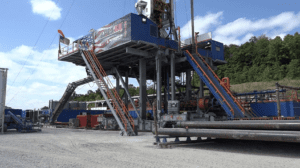MORGANTOWN, W.Va. (WBOY) — West Virginia is well known for being a gas and oil state, but now officials with that background are hoping to use their experience to spearhead the transition towards geothermal energy.
“West Virginia is obviously known for oil and gas and we are utilizing our experience mining oil and gas wells to kind of help transition our society from a typical oil and gas hydrocarbon society into a more alternative,” Northeast Natural Energy Drilling Manager, Josh Dalton, said. “We understand that this has to happen, we understand that this is going to happen and we want to be a part of it, we want to be a part of the solution.”

The first geothermal, carbon capture and storage data collection well is located right near the Morgantown Industrial Park, where drilling started last week. The well is collecting core samples and temperature data as deep as 15,000 feet and is the first geothermal study in the state.
“We have tours almost every week through the month of June,” Dalton said.
This project has been in the works for over the last year and more than 35 vendors contributed to the project’s development in one way or another.
Oversight on geothermal energy was given to the Department of Environmental Protection through House Bill 4098 back in 2022.
Northeast Natural Energy is doing the project with WVU, the U.S. Department of Energy (DOE), Patterson UTI-Energy and more.
“The successful partnership between DOE, industry and academia to test the potential
of both geothermal and carbon sequestration in the state is a significant step towards
creating new economic opportunities in clean energy diversification,” said Shikha
Sharma, geology professor in the WVU Eberly College of Arts and Sciences and the
project’s principal investigator.

WVU students will be able to receive some real-life experience through the partnership for the project.
This marks the second time WVU and Northeast Natural Energy have teamed up together for a drilling research project. The two joined together in 2015 for the Marcellus Shale Energy and Environment Laboratory, which hoped to provide a long-term field site to improve recovery efficiency and minimize environmental implications of unconventional resource development.
While the groups are evaluating the future of geothermal energy in the state, this model plans to produce data for other future projects to follow suit.
“To be clear, instead of producing energy, this well will produce data,” said Sam Taylor,
assistant director of Strategic Partnerships and Technology at the WVU Energy
Institute. “The goal is to gather enough data to decide if geothermal reservoirs in the
region can be a cleaner energy source for parts of West Virginia and mid-Appalachia,
along with collecting data on possible carbon storage.”
With that goal, officials have high hopes for the potential of the project.
“The possibilities are endless and we will see what we find,” Dalton said.


